PEUGEOT 5008 2014 Repair Manual
Manufacturer: PEUGEOT, Model Year: 2014, Model line: 5008, Model: PEUGEOT 5008 2014Pages: 404, PDF Size: 23.34 MB
Page 61 of 404
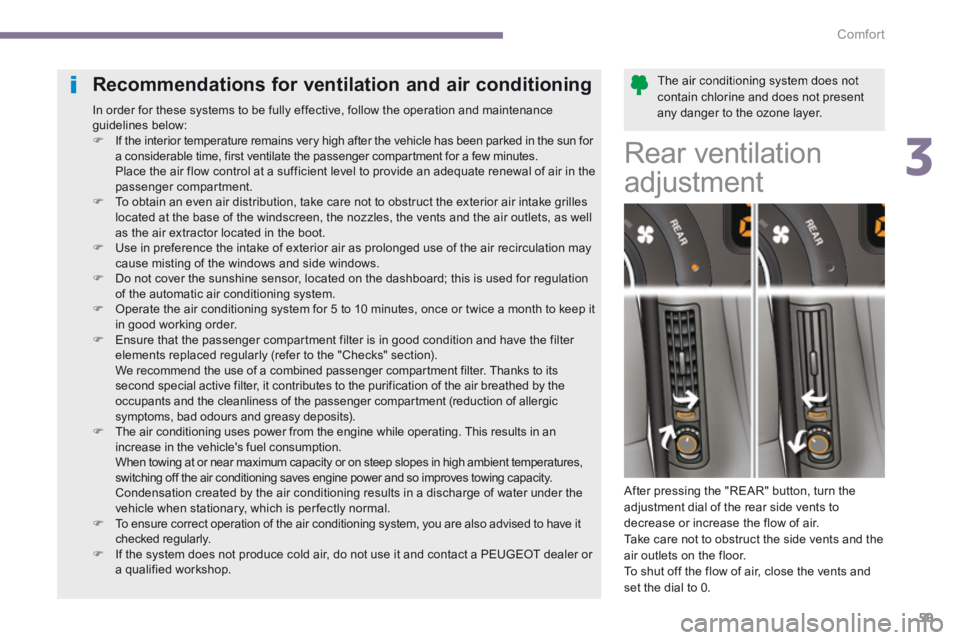
3
Comfort59
The air conditioning system does not contain chlorine and does not present any danger to the ozone layer.
Recommendations for ventilation and air conditioning
In order for these systems to be fully effective, follow the operation and maintenance guidelines below: If the interior temperature remains very high after the vehicle has been parked in the sun for a considerable time, first ventilate the passenger compartment for a few minutes. Place the air flow control at a sufficient level to provide an adequate renewal of air in the passenger compartment. To obtain an even air distribution, take care not to obstruct the exterior air intake grilles located at the base of the windscreen, the nozzles, the vents and the air outlets, as well as the air extractor located in the boot. Use in preference the intake of exterior air as prolonged use of the air recirculation may cause misting of the windows and side windows. Do not cover the sunshine sensor, located on the dashboard; this is used for regulation of the automatic air conditioning system. Operate the air conditioning system for 5 to 10 minutes, once or twice a month to keep it in good working order. Ensure that the passenger compartment filter is in good condition and have the filter elements replaced regularly (refer to the "Checks" section). We recommend the use of a combined passenger compartment filter. Thanks to its second special active filter, it contributes to the purification of the air breathed by the occupants and the cleanliness of the passenger compartment (reduction of allergic symptoms, bad odours and greasy deposits). The air conditioning uses power from the engine while operating. This results in an increase in the vehicle's fuel consumption. When towing at or near maximum capacity or on steep slopes in high ambient temperatures, switching off the air conditioning saves engine power and so improves towing capacity. Condensation created by the air conditioning results in a discharge of water under the vehicle when stationary, which is per fectly normal. To ensure correct operation of the air conditioning system, you are also advised to have it checked regularly. If the system does not produce cold air, do not use it and contact a PEUGEOT dealer or a qualified workshop.
Rear ventilation
adjustment
After pressing the "REAR" button, turn the adjustment dial of the rear side vents to decrease or increase the flow of air. Take care not to obstruct the side vents and the air outlets on the floor. To shut off the flow of air, close the vents and
set the dial to 0.
Page 62 of 404
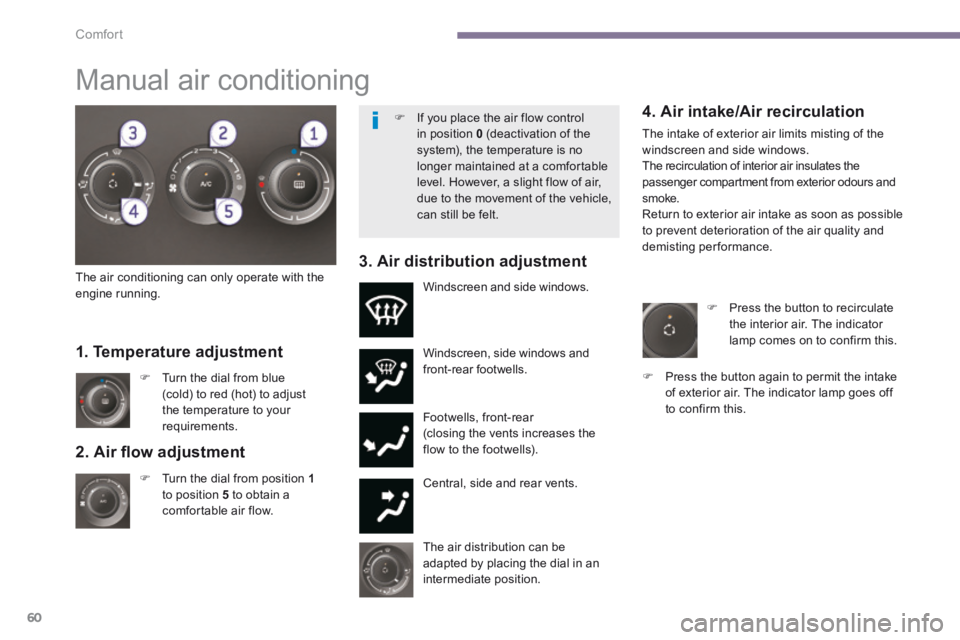
Comfort
60
2. Air fl ow adjustment
Turn the dial from position 1to position 5 to obtain a comfortable air flow.
Windscreen, side windows and front-rear footwells.
Footwells, front-rear (closing the vents increases the flow to the footwells).
Central, side and rear vents.
Turn the dial from blue (cold) to red (hot) to adjust the temperature to your requirements.
Windscreen and side windows.
1. Temperature adjustment
The air distribution can be adapted by placing the dial in an intermediate position.
The air conditioning can only operate with the engine running.
4. Air intake/Air recirculation
The intake of exterior air limits misting of the windscreen and side windows. The recirculation of interior air insulates the passenger compartment from exterior odours and smoke. Return to exterior air intake as soon as possible to prevent deterioration of the air quality and demisting performance. 3. Air distribution adjustment
Press the button to recirculate the interior air. The indicator lamp comes on to confirm this.
Press the button again to permit the intake of exterior air. The indicator lamp goes off to confirm this.
Manual air conditioning
If you place the air flow control in position 0 (deactivation of the system), the temperature is no longer maintained at a comfortable level. However, a slight flow of air, due to the movement of the vehicle, can still be felt.
Page 63 of 404
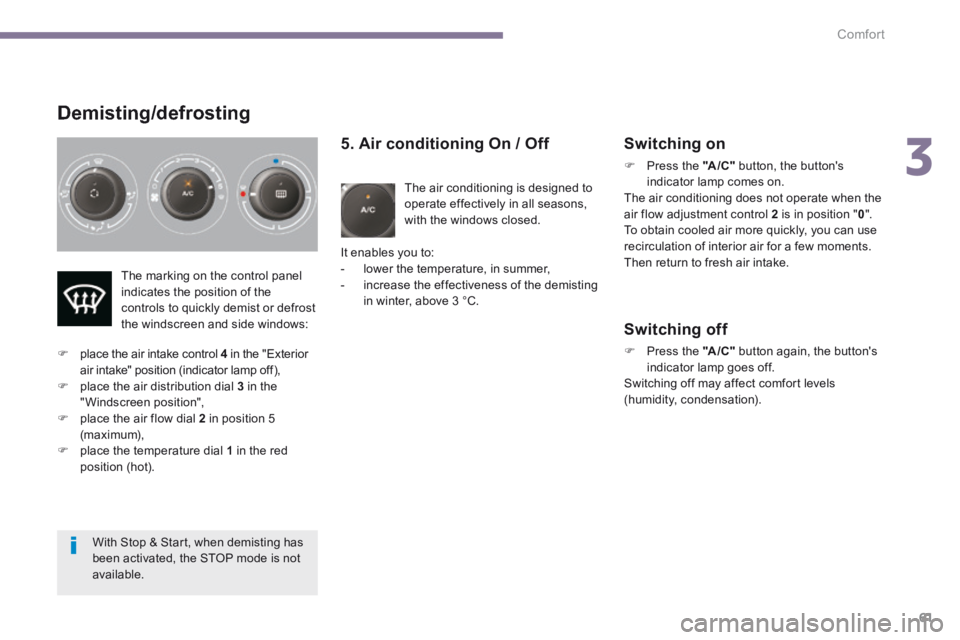
3
Comfort61
Demisting/defrosting
5. Air conditioning On / Off
The air conditioning is designed to operate effectively in all seasons, with the windows closed.
It enables you to: - lower the temperature, in summer, - increase the effectiveness of the demisting in winter, above 3 °C.
Switching on
Press the "A /C " button, the button's indicator lamp comes on. The air conditioning does not operate when the air flow adjustment control 2 is in position " 0 ". To obtain cooled air more quickly, you can use recirculation of interior air for a few moments. Then return to fresh air intake. The marking on the control panel indicates the position of the controls to quickly demist or defrost the windscreen and side windows:
place the air intake control 4 in the "Exterior air intake" position (indicator lamp off), place the air distribution dial 3 in the "Windscreen position", place the air flow dial 2 in position 5 (maximum), place the temperature dial 1 in the red position (hot).
Switching off
Press the "A /C " button again, the button's indicator lamp goes off. Switching off may affect comfort levels (humidity, condensation).
With Stop & Start, when demisting has been activated, the STOP mode is not available.
Page 64 of 404
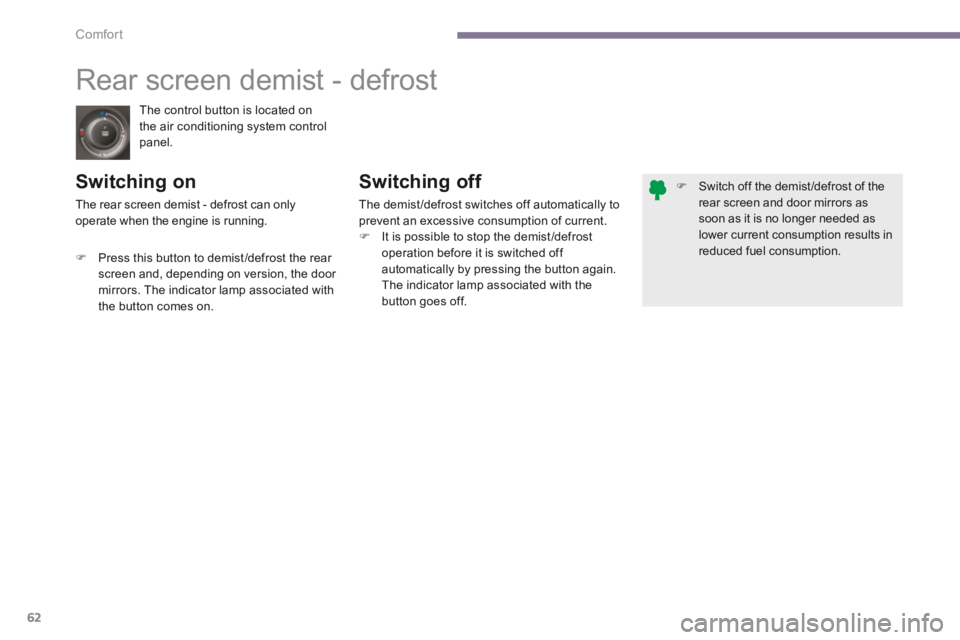
Comfort
62
The control button is located on the air conditioning system control panel.
Rear screen demist - defrost
Switching on Switching off
The demist /defrost switches off automatically to prevent an excessive consumption of current. It is possible to stop the demist /defrost operation before it is switched off automatically by pressing the button again. The indicator lamp associated with the button goes off.
Press this button to demist /defrost the rear screen and, depending on version, the door mirrors. The indicator lamp associated with the button comes on.
The rear screen demist - defrost can only operate when the engine is running.
Switch off the demist /defrost of the rear screen and door mirrors as soon as it is no longer needed as lower current consumption results in reduced fuel consumption.
Page 65 of 404
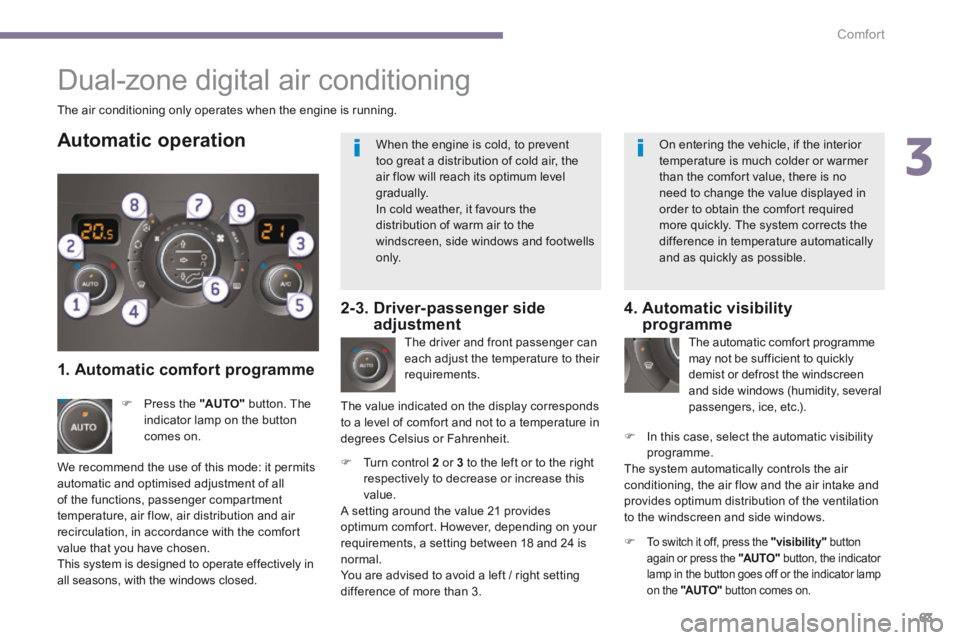
3
Comfort63
The air conditioning only operates when the engine is running.
The driver and front passenger can each adjust the temperature to their requirements.
Turn control 2 or 3 to the left or to the right respectively to decrease or increase this value. A setting around the value 21 provides optimum comfort. However, depending on your requirements, a setting between 18 and 24 is normal. You are advised to avoid a left / right setting difference of more than 3.
4. Automatic visibility programme
The automatic comfort programme may not be sufficient to quickly demist or defrost the windscreen and side windows (humidity, several passengers, ice, etc.).
In this case, select the automatic visibility programme. The system automatically controls the air conditioning, the air flow and the air intake and provides optimum distribution of the ventilation to the windscreen and side windows.
Automatic operation
Press the "AUTO" button. The indicator lamp on the button comes on.
Dual-zone digital air conditioning
We recommend the use of this mode: it permits automatic and optimised adjustment of all of the functions, passenger compartment temperature, air flow, air distribution and air recirculation, in accordance with the comfort
value that you have chosen. This system is designed to operate effectively in all seasons, with the windows closed.
The value indicated on the display corresponds to a level of comfort and not to a temperature in degrees Celsius or Fahrenheit.
To switch it off, press the "visibility" button again or press the "AUTO" button, the indicator lamp in the button goes off or the indicator lamp
on the "AUTO" button comes on.
1. Automatic comfort programme
2-3. Driver-passenger side adjustment
When the engine is cold, to prevent too great a distribution of cold air, the air flow will reach its optimum level gradually. In cold weather, it favours the
distribution of warm air to the windscreen, side windows and footwells o n l y.
On entering the vehicle, if the interior temperature is much colder or warmer than the comfort value, there is no need to change the value displayed in order to obtain the comfort required
more quickly. The system corrects the difference in temperature automatically and as quickly as possible.
Page 66 of 404
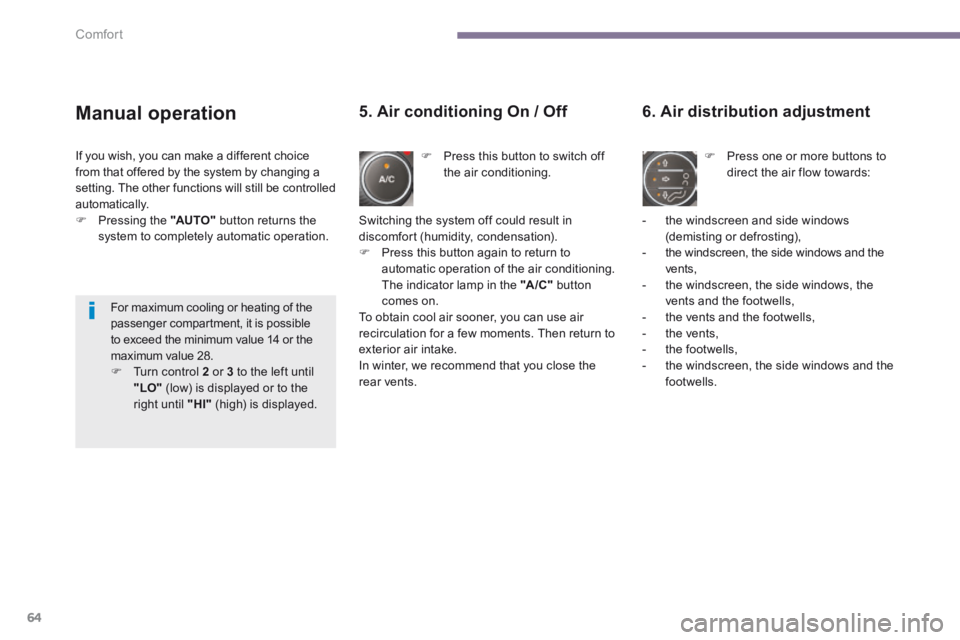
Comfort
64
Manual operation
Press this button to switch off the air conditioning.
6. Air distribution adjustment
Press one or more buttons to direct the air flow towards:
5. Air conditioning On / Off
- the windscreen and side windows
(demisting or defrosting), - the windscreen, the side windows and the vents, - the windscreen, the side windows, the vents and the footwells, - the vents and the footwells, - the vents, - the footwells, - the windscreen, the side windows and the footwells.
Switching the system off could result in
discomfort (humidity, condensation). Press this button again to return to automatic operation of the air conditioning. The indicator lamp in the "A /C " button comes on. To obtain cool air sooner, you can use air recirculation for a few moments. Then return to exterior air intake. In winter, we recommend that you close the rear vents.
If you wish, you can make a different choice
from that offered by the system by changing a setting. The other functions will still be controlled automatically. Pressing the "AUTO" button returns the system to completely automatic operation.
For maximum cooling or heating of the passenger compartment, it is possible to exceed the minimum value 14 or the maximum value 28. Turn control 2 or 3 to the left until "LO" (low) is displayed or to the right until "HI" (high) is displayed.
Page 67 of 404
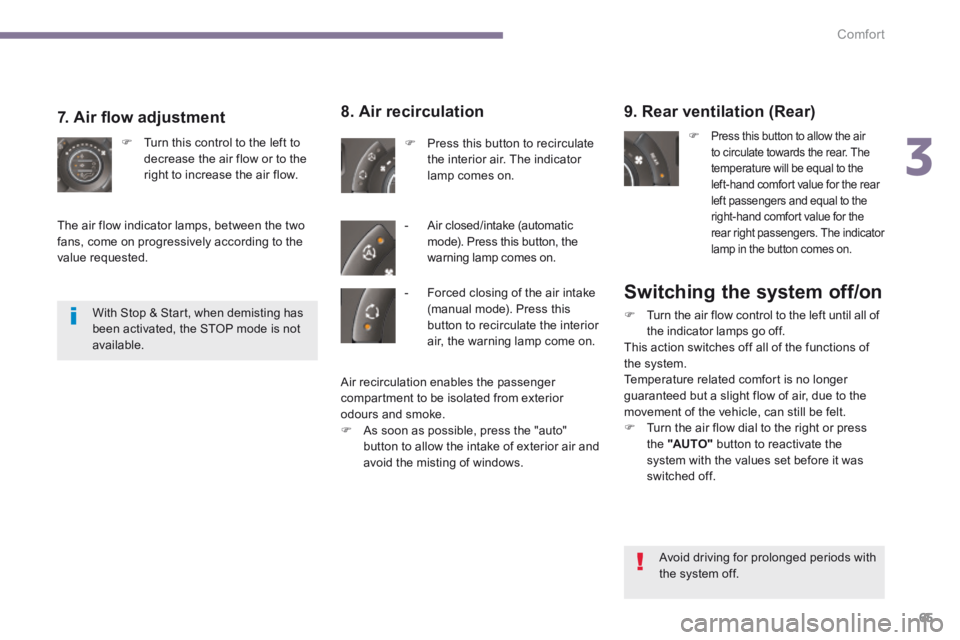
3
Comfort65
Switching the system off/on
Turn the air flow control to the left until all of the indicator lamps go off. This action switches off all of the functions of the system. Temperature related comfort is no longer guaranteed but a slight flow of air, due to the movement of the vehicle, can still be felt. Turn the air flow dial to the right or press the "AUTO" button to reactivate the system with the values set before it was switched off.
9. Rear ventilation (Rear)
Press this button to allow the air to circulate towards the rear. The temperature will be equal to the left-hand comfort value for the rear left passengers and equal to the right-hand comfort value for the rear right passengers. The indicator lamp in the button comes on.
8. Air recirculation
Press this button to recirculate the interior air. The indicator lamp comes on.
- Air closed/intake (automatic mode). Press this button, the warning lamp comes on.
7. Air fl ow adjustment
Turn this control to the left to decrease the air flow or to the right to increase the air flow.
The air flow indicator lamps, between the two fans, come on progressively according to the value requested.
With Stop & Start, when demisting has been activated, the STOP mode is not available.
Avoid driving for prolonged periods with the system off.
- Forced closing of the air intake (manual mode). Press this button to recirculate the interior air, the warning lamp come on.
Air recirculation enables the passenger compartment to be isolated from exterior odours and smoke.
As soon as possible, press the "auto" button to allow the intake of exterior air and avoid the misting of windows.
Page 68 of 404
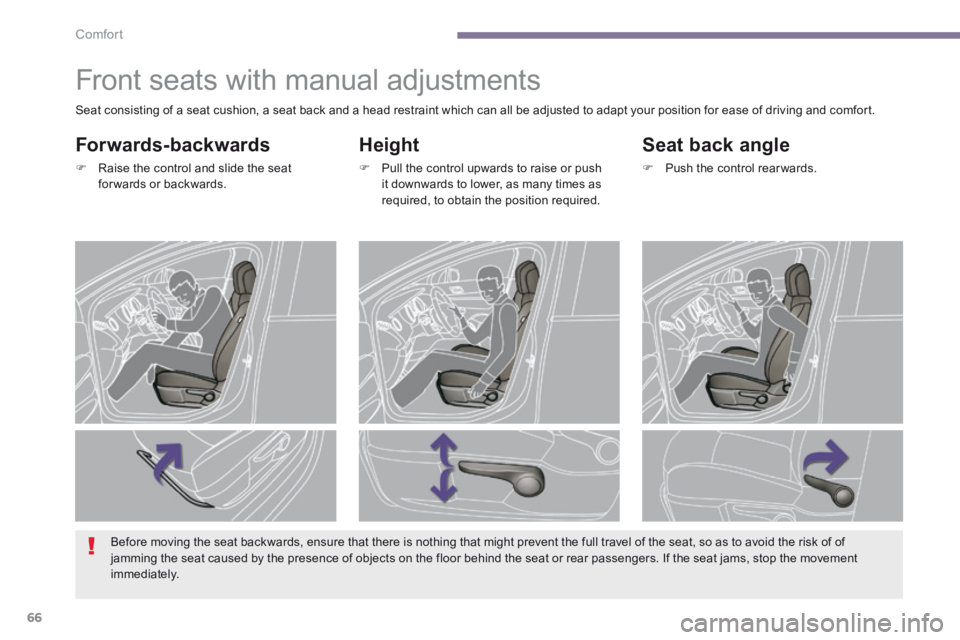
Comfort
66
Front seats with manual adjustments
Height
Pull the control upwards to raise or push it downwards to lower, as many times as required, to obtain the position required.
Seat back angle
Push the control rear wards.
Forwards-backwards
Raise the control and slide the seat for wards or backwards.
Seat consisting of a seat cushion, a seat back and a head restraint which can all be adjusted to adapt your position for ease of driving and comfort.
Before moving the seat backwards, ensure that there is nothing that might prevent the full travel of the seat, so as to avoid the risk of of jamming the seat caused by the presence of objects on the floor behind the seat or rear passengers. If the seat jams, stop the movement immediately.
Page 69 of 404
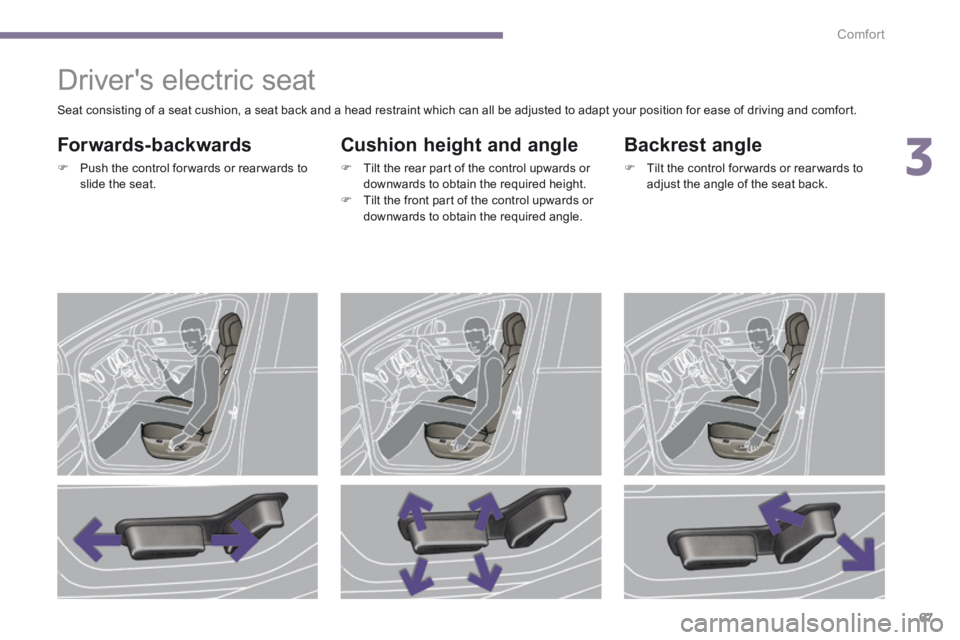
3
Comfort67
Driver's electric seat
Forwards-backwards
Push the control for wards or rear wards to slide the seat.
Cushion height and angle
Tilt the rear part of the control upwards or downwards to obtain the required height. Tilt the front part of the control upwards or downwards to obtain the required angle.
Backrest angle
Tilt the control for wards or rear wards to adjust the angle of the seat back.
Seat consisting of a seat cushion, a seat back and a head restraint which can all be adjusted to adapt your position for ease of driving and comfort.
Page 70 of 404
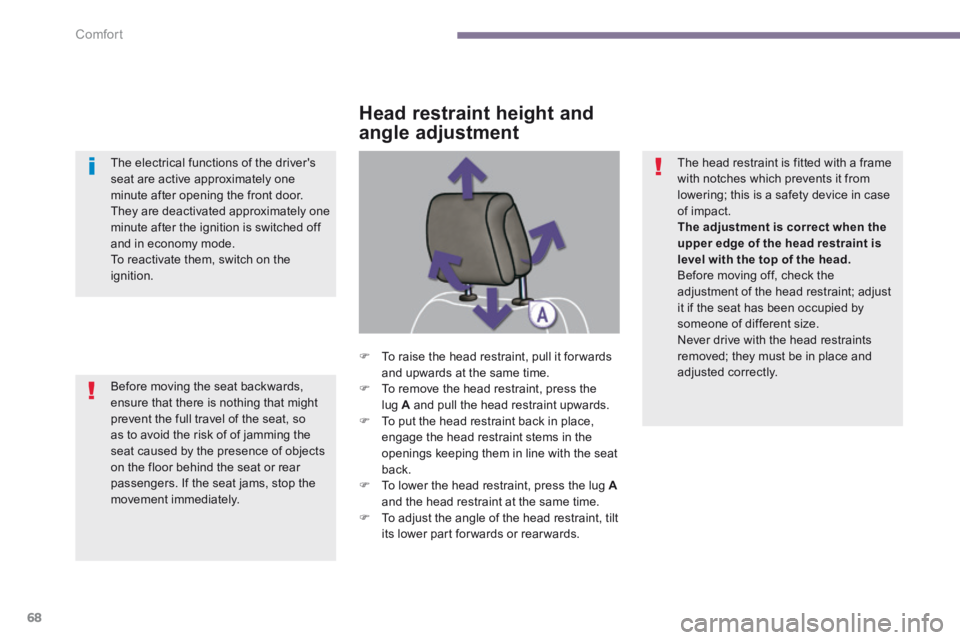
Comfort
68
Before moving the seat backwards, ensure that there is nothing that might prevent the full travel of the seat, so
as to avoid the risk of of jamming the seat caused by the presence of objects on the floor behind the seat or rear passengers. If the seat jams, stop the movement immediately.
The electrical functions of the driver's seat are active approximately one minute after opening the front door. They are deactivated approximately one minute after the ignition is switched off and in economy mode. To reactivate them, switch on the ignition.
To raise the head restraint, pull it for wards and upwards at the same time. To remove the head restraint, press thelug A and pull the head restraint upwards. To put the head restraint back in place,
engage the head restraint stems in the openings keeping them in line with the seat back. To lower the head restraint, press the lug Aand the head restraint at the same time. To adjust the angle of the head restraint, tilt its lower part forwards or rearwards.
Head restraint height and
angle adjustment
The head restraint is fitted with a frame with notches which prevents it from lowering; this is a safety device in case of impact. The adjustment is correct when the upper edge of the head restraint is level with the top of the head. Before moving off, check the adjustment of the head restraint; adjust it if the seat has been occupied by someone of different size. Never drive with the head restraints removed; they must be in place and adjusted correctly.